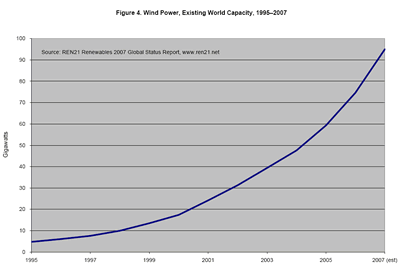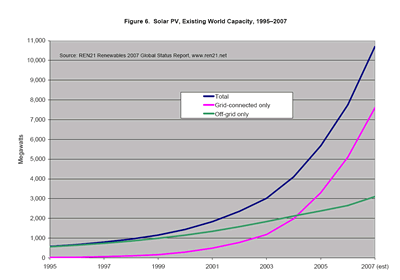Energy at a Tipping Point Part 1: A Conversation with Worldwatch's Chris Flavin
Last week I attended a discussion entitled After the Election: Where is
Cleantech Headed Now? hosted by TiE(The Indus Entrepreneurs) at their
Silicon Valley headquarters. The event was moderated by Andrew Chung
ofLightspeed Venture Partners with presentations by Chris Flavin of
Worldwatch Institute and Dr. Dick Swanson, founder of SunPower.
Needless to say, the room was full of some very smart, visionary people with
a singular focus on exploring the state of the energy sector and the
potential of renewable energy to bring solutions to a beleaguered economy
and stressed environment (one might say to civilization and the natural
systems that support it).
In my next post we’ll look at the the main ideas of Dr. Swanson’s
presentation. Here we’ll review some key points from the discussion with
Chris Flavin.

Perception lags reality
Worldwatch Institute’s Chris Flavin may have summed up the entire evening in
his first sentence: “Energy is at a tipping point”�. It is exciting to think
we live in a time of rapid transition to a new energy economy. Flavin sees
the beginnings of that transition in progress and accelerating.
Based on data from the report Renewables 2007 Global Status Report byREN21in
collaboration with Worldwatch, one challenge Flavin sees is “making the
fossil fuel industry believe”� that renewables offer a full-scale,
“baseload”� alternative to oil and coal, and that it isn’t hovering
somewhere off in the distant future.
“So much has happened in the renewable energy sector
during the past five years that the perceptions of some politicians and
energy-sector analysts lag far behind the reality of where the renewables
industry is today”�, says Mohamed El-Ashry, Chair of REN21
Explosive growth reflects a need for change
Flavin sees the dramatic shift in the energy sector coming in the next few decades based on four principal causes:
- The urgent need to reduce carbon emissions and concentrations of atmospheric CO2 within the next decade.
- Changes in energy markets and the implications for national security and economic sustainability.
- Rapid “Silicon Valley” style progress in the energy sector (think *****’s Law).
- Exponential growth in cleantech investment.

Wind
As has been reported in TriplePundit recently, wind energy development has grown at a record pace for the past four years. Globally, wind generating capacity stood nearly 100 gigawatts at the end of 2007, with an annual growth rate of about 24%. More generating capacity was added from wind in the U.S. and EU than from any other source except natural gas.
The United States, China, and India remain the most dynamic wind markets, with Spain and Germany not far behind giving ony five dominant players in the global wind market. What this means, according to Flavin, is a vast untapped market to grow wind capacity, especially in the developing world.
At a cost of about 6 cents per kilowatt-hour, wind energy is near grid parity and in some locations below.

PV Solar
The prediction that the polysilicon shortage would begin to ease this year is coming to fruition, with an expected decline in prices in the coming months and years. PV stands poised to continue to lead the pack in market expansion, with an annual global growth rate of 40%. We’ll talk more of the PV industry in my next post with Dr. Swanson of SunPower.
Biomass, biodiesel, ethanol
While some biofuel companies have been hit hard with the recent drop in oil prices, biofuel production grows at an annual rate of 20%. There are concerns with corn-based ethanol, as nearly everyone is aware. Research in second and third generation feedstocks show significant potential, but, according to Flavin, are “still a footnote” to current overall biofuel production.
Biomass from wood chips and other plant waste show great promise for power generation and heating.
Use more fossil fuel, price goes up – use more renewables, price goes down
The explosive growth rates of renewable energy compares to the 1–6% growth of fossil and nuclear energy. And with an increase in fossil energy use, the price goes up. As renewable energy consumption increases, the price goes down. When considering the externalities, environmental costs of fossil (including the coming legislative costs for carbon), the price curve gets even steeper.
The economy and policy trends, national and international
With the election of Barack Obama, the global expectation is for a sea change in the U.S. in support of the renewable energy sector. Obama has pledged $150 billion in the next 10 years in renewable energy investment, as well as setting a price on carbon. Even with concerns about a downturned economy, these new policy initiatives should help mitigate most adverse recessionary impacts. Lightspeed's Andrew Chung looks for a “shaking out” and perhaps a period of some pause, but no reversal.
With hopes of a global “New Green Deal” (or a New Deal for the 21st century), the slumping economy may actually lay the foundation for the new energy economy.
One of the most important policy initiatives, the extension of the renewable tax credit, has already happened, if only by the skin of its teeth, something we’ll discuss further with Dr. Swanson.
Internationally, policies to support renewable energy are mushrooming. Renewable energy policy targets are in place for at least 66 countries, including all 27 EU countries, 29 U.S. states (and D.C.) and 9 Canadian provinces. Most targets are for shares of electricity production, primary energy, and/or final energy by a future date – many in the 2010 to 2012 time frame, though there is an increasing number for longer-term targets toward 2020.
Keys to the challenge
Despite the optimistic outlook for renewable energy, the fact remains that fossil energy still provides 67% of world demand and renewables only 3.4% (with nuclear and large hydro making up the difference). It can’t be expected that such a large scale transition will be easy. Flavin looks to continued growth in R&D investment and rapid infratstructure (smart grid) improvements as two principal keys in meeting the challenge of the coming decades.
But it’s a challenge Chris Flavin sees as not only doable, but necessary and urgent. And based on the attendees at the event I attended last week, renewable energy is where the smart money is headed (but we knew that, didn’t we?)
In my next post will get the view from Dr. Dick Swanson of SunPower.
————-
All the charts from Flavin’s presentation (including those used in this post), based on the REN21 Renewable 2007 Global Status Report are available as a pdf
To subscribe or visit go to: http://www.triplepundit.com